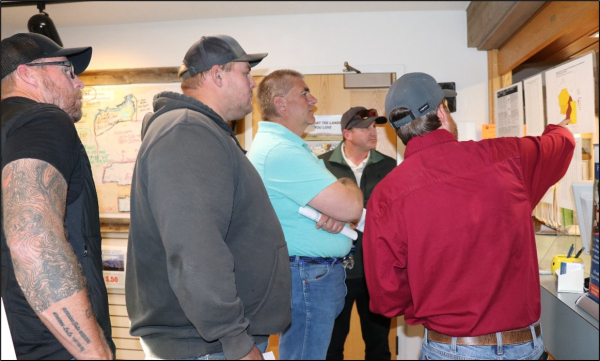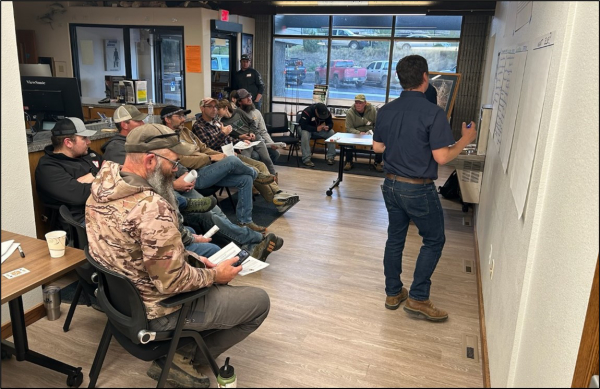
As Montana Fish, Wildlife & Parks develops a new statewide Mule Deer Management Plan, several public workshops around the state provided key insight to what hunters are thinking, what things they’d like the plan to include and opinions on key concepts for the plan.
“In parts of the state, especially eastern Montana, there’s a lot of concern over mule deer,” said FWP Director Christy Clark. “We recognize our great state’s wildlife are the public’s resources, and we need to manage them for present and future generations.”
These workshops weren’t only important for the public to have a voice, but also critical for agency staff to hear directly from hunters who are concerned about mule deer management and have ideas for the future.
“It’s important for people to know they are being heard when they voice their frustrations with the mule deer populations and how we’ve seen significant decline,” said Quentin Kujala, FWP chief of conservation policy. “People were very willing to participate in these interactive meetings and provide invaluable feedback for us to implement in our new plan.”
Nearly 150 people attended the seven workshops held at each of FWP regional headquarters offices. At the workshops, attendees rotated in small groups through interactive discussions on harvest, habitat and health management. Attendees then chose what they felt was the most important objective that arose from each session. FWP looks to use these objectives as guidelines to draft a new management plan, with several more opportunities for public input to come.
The new Mule Deer Management Plan, slated for the end of 2026, will reflect public concerns FWP has heard over the past several years, as well as the latest science and research around mule deer numbers and management. The plan will provide more comprehensive guidance for FWP as it manages mule deer and include strategies and information on management concepts that address hunting harvest, mule deer habitat conservation and herd health.

Western Montana workshop review
The meetings in western Montana were well-attended and the opinions were valuable in understanding what hunters in the area are thinking, said Liz Bradley, FWP Region 2 wildlife manager.
“We gathered a lot of good input at our meeting, combined with more thoughts that have come in since,” Bradley said. “Some things that rose to the top for west-central Montana was a good discussion of the pros and cons of general license opportunities versus limited permits. Folks here also had thoughts on habitat priorities and related research needs, predators, increased hunting pressure, CWD and ways to take an even harder stance against poaching in limited permit areas.”
These workshops provided a unique forum for hunters to share their thoughts, said Neil Anderson, FWP Region 1 wildlife manager.
"Effective wildlife management requires input from the public, and the attendees at the meeting provided valuable insight into their perspective on what it takes to manage for an increasing mule deer population in northwest Montana, something everyone agreed they would like to see," Anderson said.
Here are more ideas from western Montana workshops:
Central Montana workshop review
In central Montana, hunters also turned out in good numbers to FWP workshops to talk over mule deer management and things they’d like to see change.
“Our meeting in Bozeman showcased the passion and dedication our community has for mule deer management,” said Warren Hansen, Region 3 wildlife manager. “The thoughtful dialogue and honest feedback we received will be invaluable as we shape a new plan that reflects the values and priorities of Montanans.”
Some suggestions at the workshop in Billings included limitations on hunting seasons and permits.
“It’s important for us at FWP to hear directly from members of the hunting public at events such as this,” said Matt Ladd, Region 5 wildlife manager. “We had some productive and engaging discussions that led to creative management suggestions. Many attendees made suggestions, such as stricter permit requirements and limiting hunting during the rut, to reduce their opportunities today to ensure the longevity of this iconic Montana species into the future.”
Along with ideas for management changes, some hunters at the meeting in Billings voiced ongoing concern over CWD impacts on the deer herds. Attendees stressed the need for FWP to do more on CWD outreach and education.
Here are more ideas from the central Montana workshops:

Eastern Montana workshop review
In recent years, concerns about declining mule deer numbers have been loudest in eastern Montana where mule deer populations are still the highest in the state. Passion for mule deer hunting on the eastern Montana prairies is not only high with local hunters, but it also draws in nonresident hunters from around the country.
The workshops in Miles City and Glasgow were well attended.
In Glasgow, some of the conversation focused on CWD management, and opinions were diverse with some hunters wanting to address the disease and others wanting to see FWP take a less active role in managing the disease.
But the most engaging conversation happened around mule deer harvest.
“Our harvest management station definitely had the most interest in the room,” said Scott Thompson, FWP Region 6 wildlife manager. “The main takeaways were reducing hunter crowding and providing better opportunity for Montana residents.”
In Miles City, harvest management also dominated the discussion, and participants recognized the conflicting opinions being expressed.
“It seems like we have two contradictory things,” said landowner/outfitter Todd Steadman. “Most people want to see older class bucks, but if they are more likely to have CWD and the plan is to get rid of them, we may need to increase the public’s understanding of this concept.”
Mule deer management continues to be a complex issue, and a lot of times public opinion focuses on what hunting opportunities look like from year to year, which is understandable.
“Discussion on harvest management focused primarily on the increase in nonresident hunters, as well as what steps could be taken to increase mule deer populations when they are low,” Dorak said. “The public wants to see us increase populations by reducing antlerless harvest on all land ownerships, which is part of our strategy.”
Here are more ideas from the eastern Montana workshops:
– Montana Fish, Wildlife & Parks